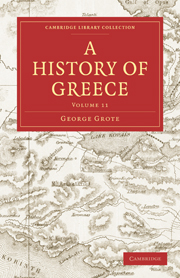Book contents
- Frontmatter
- PREFACE
- Contents
- CHAPTER LXXXIII Sicilian Affairs (continued).—From the Destruction of the Carthaginian Army by Pestilence before Syracuse, down to the Death of Dionysius the Elder
- CHAPTER LXXXIV Sicilian Affairs after the Death of the Elder Dionysius—Dionysius the Younger—and Dion
- CHAPTER LXXXV Sicilian Affairs down to the close of the Expedition of Timoleon. b.c. 353–336
- CHAPTER LXXXVI Central Greece: the Accession of Philip of Macedon to the Birth of Alexander. 359–356 b.c.
- CHAPTER LXXXVII From the commencement of the Sacred War to that of the Olynthian War
- CHAPTER LXXXVIII Euboic and Olynthian Wars
- CHAPTER LXXXIX From the Capture of Olynthus to the termination of the Sacred War by Philip
- CHAPTER XC From the Peace of 346 b.c., to the Battle of Chæroneia and the Death of Philip
CHAPTER LXXXIV - Sicilian Affairs after the Death of the Elder Dionysius—Dionysius the Younger—and Dion
Published online by Cambridge University Press: 29 August 2010
- Frontmatter
- PREFACE
- Contents
- CHAPTER LXXXIII Sicilian Affairs (continued).—From the Destruction of the Carthaginian Army by Pestilence before Syracuse, down to the Death of Dionysius the Elder
- CHAPTER LXXXIV Sicilian Affairs after the Death of the Elder Dionysius—Dionysius the Younger—and Dion
- CHAPTER LXXXV Sicilian Affairs down to the close of the Expedition of Timoleon. b.c. 353–336
- CHAPTER LXXXVI Central Greece: the Accession of Philip of Macedon to the Birth of Alexander. 359–356 b.c.
- CHAPTER LXXXVII From the commencement of the Sacred War to that of the Olynthian War
- CHAPTER LXXXVIII Euboic and Olynthian Wars
- CHAPTER LXXXIX From the Capture of Olynthus to the termination of the Sacred War by Philip
- CHAPTER XC From the Peace of 346 b.c., to the Battle of Chæroneia and the Death of Philip
Summary
Family left by Dionysius at his death
The elder Dionysius, at the moment of his death, boasted of having left his dominion “fastened by chains of adamant;” that is, sustained by a large body of mercenaries, well trained and well paid—by impregnable fortifications in the islet of Ortygia—by 400 ships of war—by immense magazines of arms and military stores—and by established intimidation over the minds of the Syracusans. These were really “chains of adamant”—so long as there was a man like Dionysius to keep them in hand. But he left no successor competent to the task; nor indeed an unobstructed succession. He had issue by two wives, whom he had married both at the same time, as has been already mentioned. By the Lokrian wife, Doris, he had his eldest son named Dionysius, and two others; by the Syracusan wife Aristomachê, daughter of Hipparinus, he had two sons, Hipparinus and Nysæus — and two daughters, Sophrosynê and Aretê. Dionysius the younger can hardly have been less than twenty-five years old at the death of his father and namesake. Hipparinus, the eldest son by the other wife, was considerably younger. Aristomachê his mother had long remained childless; a fact which the elder Dionysius ascribed to incantations wrought by the mother of the Lokrian wife, and punished by putting to death the supposed sorceress.
- Type
- Chapter
- Information
- A History of Greece , pp. 75 - 180Publisher: Cambridge University PressPrint publication year: 2010



